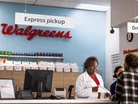Walgreens to Sell Over-the-Counter Opioid Overdose Drug

US pharmacy chain operator Walgreens Boots Alliance has launched an own-brand version of popular overdose reversal drug, naloxone, which will be available over-the-counter. The drug was approved by the US Food and Drug Administration (FDA) in April.
Reuters reports that Walgreens will begin selling its naloxone-based drug as Naloxone HCl Nasal Spray in all its stores by the end of May. The spray will be sold at $34.99 a pack.
Naloxone rapidly reverses the effects of an opioid overdose, crucially restoring normal respiration.
Opioid abuse has plagued the US for more than two decades. According to government data more than half a million Americans have died from opioid and synthetic drug use, with fentanyl a major culprit.
Naloxone was first patented in 1961 by scientists at Sankyo Company in Japan and the University of Strasbourg in France. It was approved for medical use in the US by the FDA in 1971, as an emergency treatment for opioid overdose.
In light of the Walgreen announcement we take a closer look at the use of naloxone in the US, and the pharmaceutical companies involved in making and marketing it.
A timeline of naloxone in the US
Initially, naloxone was used primarily by anesthesiologists to reverse the effects of opioid medications given during surgery. However, as the opioid crisis escalated in the 1990s and 2000s, public health officials lobbied for naloxone to be made more generally available in a bid to tackle the rising number of overdose deaths.
In 1996, Baltimore became one of the first cities to launch a community-based overdose prevention programme, providing naloxone to drug users. By 2010 an estimated 200 similar programmes were operating across the US.
In the years leading up to 2020, all 50 US states had passed laws improving widespread access to naloxone, while first responders – such as police and emergency medical technicians – were also permitted to administer naloxone.
From 2016-2021, naloxone prescriptions rose by over 1,500% as it became a vital tool in the national response to the opioid epidemic.
US pharma and naloxone: a history
Pharmaceutical companies responded to the opioid addiction epidemic by developing user-friendly naloxone products – such as auto-injectors and nasal sprays – for non-medical settings.
Kaleo’s Evzio product was approved in 2014 (but is now discontinued), while Emergent’s Narcan Nasal Spray hit the market in 2015, followed by a slew of generic naloxone products.
Narcan and Evzio were the first naloxone products specifically designed for easy administration by non-medical personnel. Narcan came at a higher price point because of the sophisticated way they were administered, compared to the cheaper injectable generic versions. The aim was to increase access by making naloxone easier for caregivers and bystanders to deploy during an opioid overdose emergency.
Naloxone is currently produced by several major pharmaceutical companies, including Hospira, Telefex, and Mylan.




